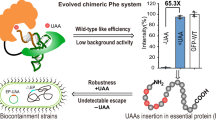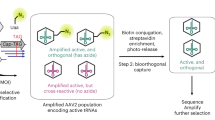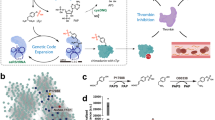Abstract
We developed a general approach that allows unnatural amino acids with diverse physicochemical and biological properties to be genetically encoded in mammalian cells. A mutant Escherichia coli aminoacyl-tRNA synthetase (aaRS) is first evolved in yeast to selectively aminoacylate its tRNA with the unnatural amino acid of interest. This mutant aaRS together with an amber suppressor tRNA from Bacillus stearothermophilus is then used to site-specifically incorporate the unnatural amino acid into a protein in mammalian cells in response to an amber nonsense codon. We independently incorporated six unnatural amino acids into GFP expressed in CHO cells with efficiencies up to 1 μg protein per 2 × 107 cells; mass spectrometry confirmed a high translational fidelity for the unnatural amino acid. This methodology should facilitate the introduction of biological probes into proteins for cellular studies and may ultimately facilitate the synthesis of therapeutic proteins containing unnatural amino acids in mammalian cells.
This is a preview of subscription content, access via your institution
Access options
Subscribe to this journal
Receive 12 print issues and online access
$259.00 per year
only $21.58 per issue
Buy this article
- Purchase on Springer Link
- Instant access to full article PDF
Prices may be subject to local taxes which are calculated during checkout




Similar content being viewed by others
References
Monahan, S.L., Lester, H.A. & Dougherty, D.A. Site-specific incorporation of unnatural amino acids into receptors expressed in mammalian cells. Chem. Biol. 10, 573–580 (2003).
Sakamoto, K. et al. Site-specific incorporation of an unnatural amino acid into proteins in mammalian cells. Nucleic Acids Res. 30, 4692–4699 (2002).
Zhang, Z. et al. Selective incorporation of 5-hydroxytryptophan into proteins in mammalian cells. Proc. Natl. Acad. Sci. USA 101, 8882–8887 (2004).
Zhang, D., Vaidehi, N., Goddard, W.A., III, Danzer, J.F. & Debe, D. Structure-based design of mutant Methanococcus jannaschii tyrosyl-tRNA synthetase for incorporation of O-methyl-L-tyrosine. Proc. Natl. Acad. Sci. USA 99, 6579–6584 (2002).
Turner, J.M., Graziano, J., Spraggon, G. & Schultz, P.G. Structural characterization of a p-acetylphenylalanyl aminoacyl-tRNA synthetase. J. Am. Chem. Soc. 127, 14976–14977 (2005).
Turner, J.M., Graziano, J., Spraggon, G. & Schultz, P.G. Structural plasticity of an aminoacyl-tRNA synthetase active site. Proc. Natl. Acad. Sci. USA 103, 6483–6488 (2006).
Kiga, D. et al. An engineered Escherichia coli tyrosyl-tRNA synthetase for site-specific incorporation of an unnatural amino acid into proteins in eukaryotic translation and its application in a wheat germ cell-free system. Proc. Natl. Acad. Sci. USA 99, 9715–9720 (2002).
Wang, L., Jackson, W.C., Steinbach, P.A. & Tsien, R.Y. Evolution of new nonantibody proteins via iterative somatic hypermutation. Proc. Natl. Acad. Sci. USA 101, 16745–16749 (2004).
Xie, J. & Schultz, P.G. A chemical toolkit for proteins—an expanded genetic code. Nat. Rev. Mol. Cell Biol. 7, 775–782 (2006).
Wang, L., Brock, A., Herberich, B. & Schultz, P.G. Expanding the genetic code of Escherichia coli. Science 292, 498–500 (2001).
Santoro, S.W., Anderson, J.C., Lakshman, V. & Schultz, P.G. An archaebacteria-derived glutamyl-tRNA synthetase and tRNA pair for unnatural amino acid mutagenesis of proteins in Escherichia coli. Nucleic Acids Res. 31, 6700–6709 (2003).
Anderson, J.C. et al. An expanded genetic code with a functional quadruplet codon. Proc. Natl. Acad. Sci. USA 101, 7566–7571 (2004).
Chin, J.W. et al. An expanded eukaryotic genetic code. Science 301, 964–967 (2003).
Chin, J.W., Cropp, T.A., Chu, S., Meggers, E. & Schultz, P.G. Progress toward an expanded eukaryotic genetic code. Chem. Biol. 10, 511–519 (2003).
Wu, N., Deiters, A., Cropp, T.A., King, D. & Schultz, P.G. A genetically encoded photocaged amino acid. J. Am. Chem. Soc. 126, 14306–14307 (2004).
Summerer, D. et al. A genetically encoded fluorescent amino acid. Proc. Natl. Acad. Sci. USA 103, 9785–9789 (2006).
Wang, J., Xie, J. & Schultz, P.G. A genetically encoded fluorescent amino acid. J. Am. Chem. Soc. 128, 8738–8739 (2006).
Zhang, Z. et al. A new strategy for the synthesis of glycoproteins. Science 303, 371–373 (2004).
Liu, C. & Schultz, P.G. Recombinant expression of selectively sulfated proteins in Escherichia coli. Nat. Biotechnol. 24, 1436–1440 (2006).
Alfonta, L., Zhang, Z., Uryu, S., Loo, J.A. & Schultz, P.G. Site-specific incorporation of a redox-active amino acid into proteins. J. Am. Chem. Soc. 125, 14662–14663 (2003).
Wang, L. & Schultz, P.G. Expanding the genetic code. Angew. Chem. Int. Edn Engl. 44, 34–66 (2004).
Bonnefond, L., Giege, R. & Rudinger-Thirion, J. Evolution of the tRNA(Tyr)/TyrRS aminoacylation systems. Biochimie 87, 873–883 (2005).
Hino, N. et al. Protein photo-cross-linking in mammalian cells by site-specific incorporation of a photoreactive amino acid. Nat. Methods 2, 201–206 (2005).
Sprague, K.U. Transcription of eukaryotic tRNA genes (AMS Press, Washington, DC, 1994).
Bedouelle, H. Recognition of tRNA(Tyr) by tyrosyl-tRNA synthetase. Biochimie 72, 589–598 (1990).
Hou, Y.M. & Schimmel, P. Modeling with in vitro kinetic parameters for the elaboration of transfer RNA identity in vivo. Biochemistry 28, 4942–4947 (1989).
Ormo, M. et al. Crystal structure of the Aequorea victoria green fluorescent protein. Science 273, 1392–1395 (1996).
Deiters, A. et al. Adding amino acids with novel reactivity to the genetic code of Saccharomyces cerevisiae. J. Am. Chem. Soc. 125, 11782–11783 (2003).
Acknowledgements
This work was funded by a US National Institutes of Health grant GM62159. This is manuscript 18455 of the Scripps Research Institute.
Author information
Authors and Affiliations
Contributions
W.L. developed and evaluated the method, A.B. carried out the MS analysis, Shou C. and Shuibing C. helped with protein characterization, and W.L. and P.G.S. designed the project, analyzed the data and prepared the manuscript.
Corresponding author
Ethics declarations
Competing interests
The authors declare no competing financial interests.
Supplementary information
Supplementary Fig. 1
Amber suppression is dependent upon both the EcTyrRS and BstRNATyrCUA genes in both T-rex CHO and T-rex 293 cells. (PDF 51 kb)
Supplementary Fig. 2
Western blot analysis of expression of six EcTyrRS variants in T-rexTM CHO and 293 cells. (PDF 46 kb)
Supplementary Fig. 3
ESI-TOF MS spectrum of affinity purified wild-type GFP. (PDF 14 kb)
Supplementary Fig. 4
Annotated tandem MS spectra of the peptide FSVSGEGEGDATY*GK from mutant GFP containing pAzpa. (PDF 56 kb)
Rights and permissions
About this article
Cite this article
Liu, W., Brock, A., Chen, S. et al. Genetic incorporation of unnatural amino acids into proteins in mammalian cells. Nat Methods 4, 239–244 (2007). https://doi.org/10.1038/nmeth1016
Received:
Accepted:
Published:
Issue Date:
DOI: https://doi.org/10.1038/nmeth1016
This article is cited by
-
Autoregulation of GPCR signalling through the third intracellular loop
Nature (2023)
-
Virus-assisted directed evolution of enhanced suppressor tRNAs in mammalian cells
Nature Methods (2023)
-
Ribosome-mediated biosynthesis of pyridazinone oligomers in vitro
Nature Communications (2022)
-
Overexpression of recombinant proteins containing non-canonical amino acids in Vibrio natriegens: p-azido-L-phenylalanine as coupling site for 19F-tags
Amino Acids (2022)
-
Functional genetic encoding of sulfotyrosine in mammalian cells
Nature Communications (2020)



